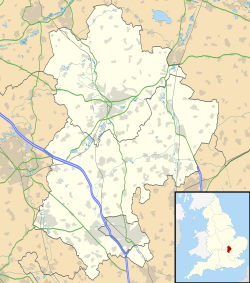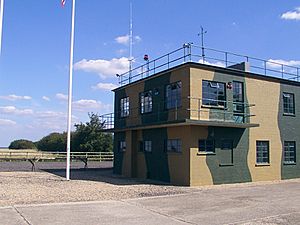RAF Twinwood Farm facts for kids
Quick facts for kids RAF Twinwood FarmUSAAF Station 506 |
|||||||||||
|---|---|---|---|---|---|---|---|---|---|---|---|
| Bedford, Bedfordshire in England | |||||||||||

Aerial photograph, 28 March 1948
|
|||||||||||
|
Shown within Bedfordshire
|
|||||||||||
| Coordinates | 52°10′52″N 0°29′10″W / 52.181102°N 0.486131°W | ||||||||||
| Type | Satellite Station | ||||||||||
| Code | TF | ||||||||||
| Site information | |||||||||||
| Owner | Air Ministry | ||||||||||
| Operator | Royal Air Force United States Army Air Forces |
||||||||||
| Controlled by | RAF Fighter Command 1942- Eighth Air Force |
||||||||||
| Site history | |||||||||||
| Built | 1941/42 | ||||||||||
| In use | April 1942 - June 1945 | ||||||||||
| Battles/wars | European theatre of World War II | ||||||||||
| Airfield information | |||||||||||
| Elevation | 84 metres (276 ft) AMSL | ||||||||||
|
|||||||||||
RAF Twinwood Farm was an important airfield during World War II. It was a special kind of air base called a satellite station. This base is located about 4 miles north of Bedford, Bedfordshire, England. For most of the war, it was home to Royal Air Force (RAF) planes that flew at night. These planes were called night fighters.
Contents
RAF Twinwood Farm: A World War II Airfield
Twinwood Farm started as an airfield in mid-1941. At first, it was just a grass field. By April 1942, it had three concrete runways. It also had extra temporary buildings for the people working there.
From 1942 until the end of the war, many different planes used Twinwood. These included Bristol Blenheims, Bristol Beaufighters, and de Havilland Mosquitoes. These planes belonged to No. 51 Operational Training Unit. This unit helped train pilots and crews.
In March 1943, North American Mustangs from several RAF squadrons used the base. They took part in a big training exercise called Operation Spartan. This exercise tested how British and Canadian forces would work together. It happened across southern and central England.
RAF Squadrons and Units at Twinwood
Many different RAF groups used Twinwood Farm. These included:
- No. 26 Squadron RAF
- No. 268 Squadron RAF
- No. 613 Squadron RAF
- No. 169 Squadron RAF
- No. 239 Squadron RAF
- No. 164 Squadron RAF
- No. 14 Service Flying Training School RAF
- No. 19 Air Crew Holding Unit
- No. 2837 Squadron RAF Regiment
- Airborne Interception Conversion Flight RAF
American Forces at Twinwood Farm
In 1944, the airfield was given to the United States Army Air Forces (USAAF). It worked closely with another nearby American air base, RAF Thurleigh. This helped the American forces in their war efforts.
The Mystery of Glenn Miller's Disappearance
Glenn Miller was a famous American bandleader. During World War II, he became a major in the US Army Air Forces. He led the Army Air Forces Band. General Eisenhower asked Miller and his band to go to Europe in June 1944. Their job was to broadcast music and perform for the troops.
They were based near Bedford, England. They broadcast from BBC facilities there and also from London. The band performed at many air bases across the UK.
In December 1944, Miller's unit was moving from England to France. Miller was ordered to go ahead to make arrangements. Bad weather caused flights from another base to be canceled. On December 15, 1944, Miller accepted a ride to France. He flew with Lt. Col. Norman Baessell on a small plane called a UC-64.
The plane took off from Twinwood Farm at 1:55 PM. The UC-64 and the people on board were never seen again.
In January 1945, an investigation found that the plane likely crashed over the English Channel. This was due to a mix of human error, mechanical problems, and bad weather. The plane's remains have never been found. Major Glenn Miller is still listed as missing in action. His name and the names of the other two missing servicemen are on a memorial in Cambridge, England.
Twinwood Farm Today: A Place for Music and History
The airfield officially closed in June 1945 after the war ended.
Today, the site is home to the Twinwood Arena. This is a large outdoor area that hosts music festivals. One popular event is the Rhythm Festival.
The Glenn Miller Museum
The Glenn Miller Museum is located in the old control tower of the airfield. This tower was restored in 2002. The museum has exhibits about Glenn Miller, RAF Twinwood Farm, and World War II.
Other buildings at the site also have interesting displays:
- Twinwood Aviation Museum shows uniforms and items found from crashed German and Allied aircraft. It also covers British aviation and life in Britain during the war.
- You can see rooms set up like a family home from the 1940s.
- The Axis Museum has a recreated German bunker. It also displays Russian and German weapons. There is a special exhibit about Winston Churchill and the British royal family.
- The Fire Service Museum looks like a wartime fire station from the 1940s. It has uniforms, equipment, and old fire vehicles.
- There are also displays of military vehicles.
These museums are sometimes called the Twinwood Airfield Museum. They are open during certain times of the year.
More to Explore
- List of former Royal Air Force stations
- Glenn Miller Orchestra




